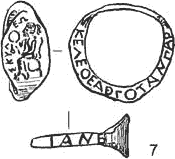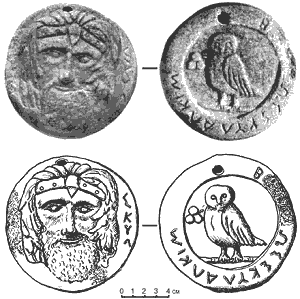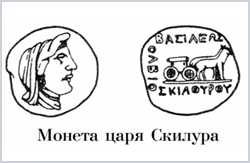Links
http://public.kubsu.ru/~usr02898/sl28.htm
http://archaeology.kiev.ua/journal/020301/ryabova_lezhukh.htm
Golden ring
The name of the Scythian king Skil (470-450 BC) on a Scythian golden finger-ring (Ryabova and Lezhukh 2001: figure 7, 7). Found in 1930-es near Istria in Romania. According to The History of Herodotus (Book 4), this Hellenized king, the son of the Scythian king Ariapif (490-470 BC) and a Grecian woman from Istria, was dethroned and fled to Thrace. Most likely, the name Skil is not Scythian, and possibly is a Thracian name. Skil was buried not in a kurgan, like his fellow tribesmen, but in a Greek-style vault. The surrounding Scythian tribes were Neuri and Budini, the Cimmerian aborigines, and settled Greeks and Thracians.

|
Most likely, the name Skil is precisely Scythian, "Sk" is ethnic name, "Il" is
"country", "Sk" is analogous to the Bulgarian "Bl" in "Blgar" and "Ml" in "Mlgar",
which in the surrounding languages gained a prosthetic vowel: Bulgar, Bolgar,
Balkar, Malkar, and eventually were adopted by the local Türkic
languages, sometimes retaining an old pronunciation along with a new one, B'lgar
and Bulgar. The endoethnonym "Sk" is an obvious part of both exoethnonyms
Scyth and Saka, with all their variations. The constructions of the type "Türk-el" and
"El-terish" are very numerous throughout the Türkic history, as was a custom of naming
a ruler with his ethnic name like Ezgil Kül-erkin, Sibir Kagan. "Sk" appears in a
number of ruling title-names: Skil, Skilur, Skileo, which indicates a strong tradition
in the composition of the Scythian titles. To the same morphological group belongs the name of another prominent Scythian leader, called in the Greek sources Ateus. His name was Ata-il, "Father of the country", another popular Türkic construct best illustrated by the "Father of the Türks" Atatürk, his predecessor Atilla, with many other examples to spare. Incidentally, the Scythian land in between the Danube and the Buh in Late Antique and through the Middle Ages was called Atil Kiji , with a literal meaning the father-land of the people. A king, or actually a head of the nomadic confederation, a concept apparently foreign to the Greeks, who depicted the Scythians with their own concept of a hereditary ruler, of the Atil Kiji land or state would appropriately carry a title-name Atil. Ateus (Ατεας, Atheas) - Scythian king, who at the turn of the 4th-5th cc. BC created a strong Scythian kingdom in the lower Bug/Buh and lower Danube area. In 339, at age 90, he was killed in a battle with Philip of Macedon. The name Ateus/Ateas/Atei (Ατεας, Atheas) is a Greek distortion, manifestant of other distortions that historians and linguists take for academic-level spelling and even try to perfect by using all kinds of convoluted diacritics, like Áţĥėãš, akin to showing mm at a distance eyeballed at about 2 days of travel. We know how Atails - not Atheas - coined his name:  Unfortunately, our source for the Türkic inscriptions in Greek alphabet is Slavophile S.V.Ryabchikov, whose comments are not too educational. |
The first inscription in Greek letters
SKULEW
Transcription
Skileo
The second inscription in Greek letters
SKELEOEARGOTANGAR
Transcription
Skeleoeargotangar
S.V.Rjabchikov gives a reading
Skel Eo e ar; gota ngar
S.V.Rjabchikov: It signifies 'Skel (= Skyl) Eo is an Aryan; (he) left a town'. The key words to this text are Old Indian gata 'gone' (cf. Russian hodit' 'to go') and Old Indian nagr 'town' (cf. Russian gorod 'town').
The third inscription
IANR
Transcription
Ianr
S.V.Rjabchikov: I.e. Ia nr. It means 'And (even) the hero'. The key words to this text are Old Indian nr 'hero' (1) and Old Church Slavonic i 'and; and even'.
Pendant

The above text is parallel to the Greek text of a pendant (2):
BASILEWS SKUL ALKIM
Transcription
Basileos Skyl Alkim
S.V.Rjabchikov: 'Of the brave king Skyl'.
Coin of King Skilur

Scythian vessel
2. The sign of a star and the brief record in Greek letters on a Scythian vessel (Dashevskaya 1991: 111, table 55, figure 4). The word ai may be compared with Sindian ait 'light' (3), Russian yasny 'clear; bright', South Russian yaska 'star'. On the other hand, the word ai is comparable with Hittite eia 'the World Tree' (4).
AI
|
In Türkic "Ai/Ay" is moon, but out of context that can be anything. |
Sidekick
3. A Scythian wall record (Dashevskaya 1991: 60, table 4, figure 1) contains in particular some signs, see figure 1.

Figure 1.
S.V.Rjabchikov: Near the sign of a horse there is the text 12 10 76 sura, cf. Old Indian surya 'the sun'. Actually, the horse is equal to the fire in the Indo-Aryan beliefs (Propp 1998: 264). Moreover, the Old Indian god Surya correlates with the horses (Toporov 1992: 478). I think that the decoded fragment reports about the solar horse.
|
S.V.Ryabchikov would be more productive to investigate what group had the depicted tamga. |
NOTES
2. See Ryabova and Lezhukh 2001.
3. See Trubachev 1977: 19.
4. See Shilov 1995: 195.
REFERENCES
Afanasiev, A., 1996. Proiskhozhdenie mifa. Stat'i po fol'kloru, etnografii i mifologii. Moscow: Indrik.
Dashevskaya, O.D., 1991. Pozdnie skify v Krymu. Arkheologiya SSSR. Svod arkheologicheskikh istochnikov. Vol. D 1-7. Moscow: Nauka.
Propp, V.Y., 1998. Morfologiya/Istoricheskie korni volshebnoy skazki. Moscow: Labirint.
Rjabchikov, S.V., 2000. Tmutarakanskie graffiti. Krasnodar: Stil.
Ryabova, V.A. and I.P. Lezhukh, 2001. "Chernaya arkheologiya" i istoriya skifskogo tsarya Skila. Vostochnoevropeysky arkheologichesky zhurnal, vol. 9(2).
Shilov, Y.A., 1995. Prarodina Ariev: Istoriya, obryady i mify. Kiev: SINTO.
Toporov, V.N., 1992. Sur'ya. In: S.A. Tokarev (ed.) Mify narodov mira. Vol. 2. Moscow: Sovetskaya Entsiklopediya, pp. 477-8.
Trubachev, O.N., 1977. Lingvisticheskaya periferiya drevneyshego slavyanstva. Indoariytsy v Severnom Prichernomor'e. Voprosy yazykoznaniya, No 6: 13-31.
ηγčšöïäü
E. Herzfeld,
"Pasargadae. Untersuchungen zur persischen Archäologie",Klio, 1908
E. Herzfeld, "Bericht über die Ausgrabungen von Pasargadae, 1928
E. Herzfeld, "Rapport sur l'état actuel des ruines de Persépolis etpropositions pour leur conservation